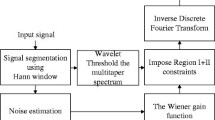Abstract
In this paper, we will present a Kalman filtering algorithm that achieves better noise reduction in a single-channel speech enhancement application. The proposed method aims to tune the Kalman filter gain in order to offset the bias that is inherent when estimating speech parameters from noise-corrupted speech. After analysing the Kalman recursion equations and the filter gain, the sensitivity metric was shown to be useful in tuning the Kalman filter to achieve better noise reduction. Speech enhancement experiments were performed on the commonly available NOIZEUS database corrupted with white Gaussian noise, and the proposed method was evaluated and compared with recent speech enhancement methods, such as the STSA estimator with wavelet thresholding on multi-tapered spectra (or STSA-WT) and generalised subspace method. The proposed method was shown to produce better quality speech than the STSA-WT estimator, while being competitive with the generalised subspace method. Spectrogram analysis demonstrated that the proposed method could achieve similar levels of noise reduction to the Kalman filter in the oracle case.







Similar content being viewed by others
Notes
The MATLAB code and sample speech output files are available and can be downloaded at http://tiny.cc/speech_enhancement.
Note that we will use the ‘negative sign’ convention, as is commonly used in linear prediction analysis [3].
We used bold variables to denote matrix/vector quantities, as opposed to unbolded variables for scalar quantities.
In this study, we are assuming the effects of the white noise on the estimates of \(a_k\) are negligible, in comparison with the variance of the measurement noise \(\sigma _v^2\), i.e. \(\tilde{a}_k\approx a_k\).
The MATLAB code and sample speech output files are available and can be downloaded at http://tiny.cc/speech_enhancement.
References
S. Boll, Suppression of acoustic noise in speech using spectral subtraction. IEEE Trans. Acoust. Speech Signal Process. ASSP–27(2), 113–120 (1979)
J.D. Gibson, B. Koo, S.D. Gray, Filtering of colored noise for speech enhancement and coding. IEEE Trans. Signal Process. 39(8), 1732–1742 (1991)
M.H. Hayes, Statistical Digital Signal Processing and Modeling (Wiley, New Jersey, 1996)
S. Haykin, Adaptive Filter Theory. Prentice Hall Information and System Sciences Series, 4th edn. (Prentice-Hall, New Jersey, 2002)
Y. Hu, P. Loizou, A generalized subspace approach for enhancing speech corrupted by colored noise. IEEE Trans. Speech Audio Process. 11, 334–341 (2003)
Y. Hu, P. Loizou, Speech enhancement based on wavelet thresholding the multitaper spectrum. IEEE Trans. Speech Audio Process. 12(1), 59–67 (2004)
Y. Hu, P. Loizou, evaluation of objective measures for speech enhancement. Proc. Interspeech 2006, 1447–1450 (2006)
Y. Hu, P. Loizou, Subjective evaluation and comparison of speech enhancement algorithms. Speech Commun. 49, 588–601 (2007)
R.E. Kalman, A new approach to linear filtering and prediction problems. J. Basic Eng. Trans. ASME 82, 35–45 (1960)
J.S. Lim, A.V. Oppenheim, All-pole modeling of degraded speech. IEEE Trans. Acoust. Speech Signal Process. ASSP–26, 197–210 (1978)
P. Loizou, Speech Enhancement: Theory and Practice, 1st edn. (CRC Press LLC, Boca Raton, 2007)
K.K. Paliwal, A. Basu, A speech enhancement method based on Kalman filtering, in Proceedings of the IEEE International Conference Acoustics, Speech, and Signal Processing, vol. 12, pp. 177–180 (1987)
A. Rix, J. Beerends, M. Hollier, A. Hekstra, Perceptual evaluation of speech quality (PESQ), an objective method for end-to-end speech quality assessment of narrowband telephone networks and speech codecs. ITU-T Recommendation P.862. Technical report, ITU-T (2001)
M. Saha, R. Ghosh, B. Goswami, Robustness and sensitivity metrics for tuning the extended Kalman filter. IEEE Trans. Instrum. Meas. 63(4), 964–971 (2014)
S. So, A.E.W. George, R. Ghosh, K.K. Paliwal, A non-iterative Kalman filtering algorithm with dynamic gain adjustment for single-channel speech enhancement. Int. J. Signal Process. Syst. 4(4), 263–268 (2016)
S. So, K.K. Paliwal, Modulation-domain Kalman filtering for single-channel speech enhancement. Speech Commun. 53(6), 818–829 (2011)
S. So, K.K. Paliwal, Suppressing the influence of additive noise on the Kalman filter gain for low residual noise speech enhancement. Speech Commun. 53(3), 355–378 (2011)
S. So, K.K. Wojcicki, K.K. Paliwal, Single-channel speech enhancement using Kalman filtering in the modulation domain, in Proceedings of the Interspeech 2010 (2010)
P. Sorqvist, P. Handel, B. Ottersten, Kalman filtering for low distortion speech enhancement in mobile communication, in Proceedings of the IEEE International Conference Acoustics, Speech, Signal Processing, vol. 2, pp. 1219–1222 (1997)
N. Wiener, The Extrapolation, Interpolation, and Smoothing of Stationary Time Series with Engineering Applications (Wiley, New York, 1949)
W.R. Wu, P.C. Chen, Subband Kalman filtering for speech enhancement. IEEE Trans. Circuits Syst. II 45(8), 1072–1083 (1998)
Acknowledgments
We would like to thank the anonymous reviewers of this manuscript. Their feedback was extremely helpful in improving the clarity and quality of the manuscript.
Author information
Authors and Affiliations
Corresponding author
Rights and permissions
About this article
Cite this article
So, S., George, A.E.W., Ghosh, R. et al. Kalman Filter with Sensitivity Tuning for Improved Noise Reduction in Speech. Circuits Syst Signal Process 36, 1476–1492 (2017). https://doi.org/10.1007/s00034-016-0363-y
Received:
Revised:
Accepted:
Published:
Issue Date:
DOI: https://doi.org/10.1007/s00034-016-0363-y




